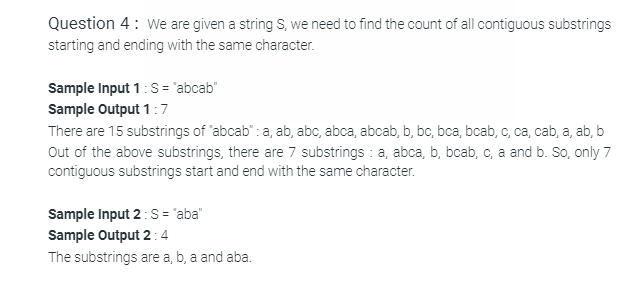🚀Day 19/180 Counting all contiguous substrings starting and ending with the same character.(Using Recursive function)
 Aniket Verma
Aniket VermaCounting all contiguous substrings starting and ending with the same character.(Using Recursive function)

The provided Java program calculates the number of palindromic substrings in a given string. The main method initializes a string "abcab" and calls the countSubstrs method to compute and print the result.
Here is a detailed explanation of the code:
Base Cases:
If the length of the substring
nis 1, it returns 1 because any single character is a palindrome.If
nis less than or equal to 0, it returns 0 because there are no valid substrings to check.
Recursive Calculation:
The function recursively calculates the number of palindromic substrings by:
Excluding the current character at index
iand considering the substring fromi+1toj.Excluding the current character at index
jand considering the substring fromitoj-1.Excluding both characters at index
iandjand considering the substring fromi+1toj-1.
It subtracts the count of substrings excluding both
iandjto avoid double-counting.
Checking for Palindromes:
- If the characters at indices
iandjare equal, it increments the result by 1 since this pair forms a palindromic substring.
- If the characters at indices
Main Method:
The main method initializes the string "abcab" and its length
n.It then calls the
countSubstrsmethod with initial values0(start index),n-1(end index), andn(length of the substring).The result is printed to the console.
Here is the provided code with comments for better understanding:
public class Main {
// Method to count palindromic substrings
public static int countSubstrs(String str, int i, int j, int n) {
// Base case: single character substring
if (n == 1) {
return 1;
}
// Base case: invalid substring
if (n <= 0) {
return 0;
}
// Recursive case
int res = countSubstrs(str, i + 1, j, n - 1) +
countSubstrs(str, i, j - 1, n - 1) -
countSubstrs(str, i + 1, j - 1, n - 2);
// Check if the current substring is a palindrome
if (str.charAt(i) == str.charAt(j)) {
res++;
}
return res;
}
// Main method
public static void main(String[] args) {
String str = "abcab";
int n = str.length();
System.out.print(countSubstrs(str, 0, n - 1, n));
}
}
When executed, the program prints 7, which is the number of palindromic substrings in the string "abcab".
Subscribe to my newsletter
Read articles from Aniket Verma directly inside your inbox. Subscribe to the newsletter, and don't miss out.
Written by
